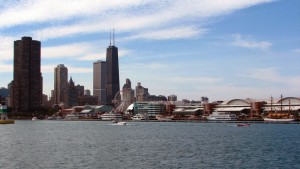Water rates continue double-digit climb
Kevin Beese — March 7, 2015
Lake Michigan, a cash cow for Chicago, which supplies water to the suburbs. Chicago area residents have seen rates increase by about 60 percent over the last four years. Photo by Benjamin D. Esham
While there are many appealing aspects to being in Santa Fe, N.M., right now, paying the water bill would not be one of them.
Although rates throughout the Chicago area have skyrocketed over the past four years, they still pale in comparison to Santa Fe’s water bills, which, in some categories, are nearly five times Chicago area bills. So, that can be some solace as you keep putting on a stocking hat and gloves.
Chicago area residents are paying 60 percent more for water now than they did four years ago, but the average water bills for area customers are substantially better than communities in the Western states. The average monthly bill of $59.58 for a Chicago area family of four using 150 gallons of water per person per day is still half of what that same family would pay in Los Angeles ($122.41), Seattle ($153.22) or Santa Fe ($284.10), according to Circle of Blue, a foundation which reports on the world’s resource crises.
Before sending that thank-you card to Chicago Mayor Rahm Emanuel and other Chicago officials, however, know that that $59.58 monthly rate average for the Chicago area in 2014 was the third biggest jump for all the cities that Circle of Blue surveyed.
The 24.9 percent hike in Chicago area customers’ average bill between 2013 and 2014 was only topped by Fresno (50.9 percent) and San Diego (29.4 percent) And that does not take into account the 15 percent rate hike for 2015 that Chicago has passed along to water purchasers.
Chicago has said the rate hikes in 2012-15 were required to pay for infrastructure improvements to the aging water delivery system.
The city raised water rates 25 percent in 2012 and 15 percent annually in 2013, 2014 and 2015.
Even though this is supposed to be the end of the double-digit increases, municipalities that buy their water from Chicago either directly or indirectly are keeping a wary eye on the Second City.
“It’s problematic. Chicago has to balance their budget,” Burr Ridge Trustee Guy Franzese said at a recent meeting. “I doubt this is the end of it. I expect the increases to continue. This is a cash cow for them.”
Burr Ridge Village Administrator Steve Stricker said at that same meeting that the city’s rate hikes going forward are only supposed to be cost-of-living increases, but that with Chicago’s financial problems nothing is untouchable.
“They are in dire straits and they do see this as a cash cow,” Stricker said of the city’s selling of water to suburbs, “but there is only so much they can expect from us.”
In order to stem future rate hikes, state Rep. Emmanuel “Chris” (Welch, D-7th), has proposed legislation that would create the Water Rate Protection Board that would hold hearings and regulate water rates for municipal providers with a population of more than 500,000.



